by Cynthia B. Arre | Apr 22, 2020 | Advocacies, Downloadables
Happy Earth Day! Even in this time of Covid-19, let’s also think about the steps we can take to protect the home that has nurtured us since we were born. It can be as simple as reducing (if not, completely avoiding) the use of single-use plastic, walking instead of taking your car, supporting our farmers and forest watchers, recycling / repurposing old items instead of throwing them away, and composting kitchen waste, among others. A healthy environment can also care for us more efficiently as we fight this pandemic together.
Also taking this moment to spread the love for our Philippine native trees and their importance in forest conservation and protection. Without our forests, our food and water security will be compromised andof course we can’t allow that to happen especially during this very challenging period.
Sharing these desktop and mobile wallpapers featuring some of the fruit-bearing trees that Forest Foundation Philippines and I showcased in our ongoing #ForestFruitsPh project.You can download them straight from FFP’s site, provided through the links below. Feel free to share them with your friends, hopefully along with the message of conservation. 🙂
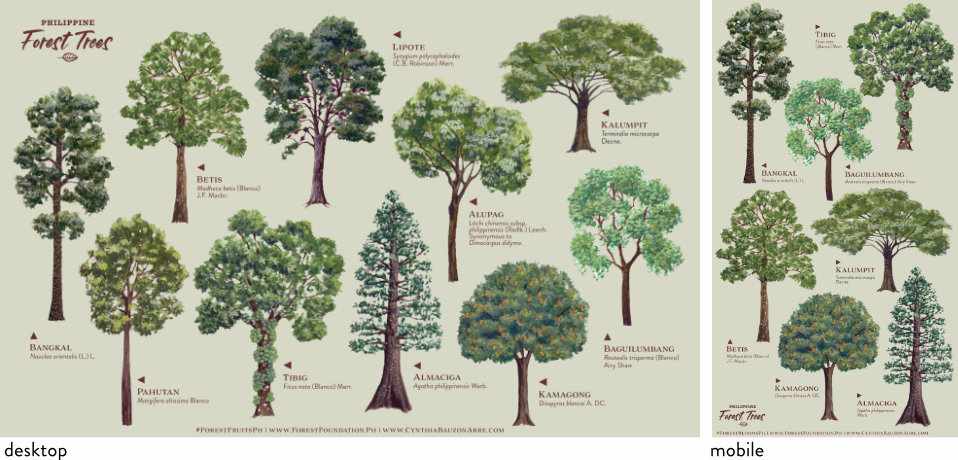
Download from Forest Foundation Philippines:
#ForestTreesPh desktop wallpaper (2880 x 1800)
#ForestTreesPh mobile wallpaper (750 x 1334)
by Cynthia B. Arre | Apr 12, 2020 | Advocacies
Along with WWF Philippines, I am inviting you to help support our forest frontliners, the Bantay Gubat. Our water security relies greatly on them, and in these times of pandemic, we know just how important it is to have clean water at the ready. (I mean, how do we wash our hands without a supply of fresh water? How will our healthcare workers care for patients efficiently without it, right? We normally take our water supply for granted because it’s there everyday, not knowing that unsung heroes working behind the scenes also need our help. ( I wasn’t aware as well until I learned all about what they do so I am sharing it here.)
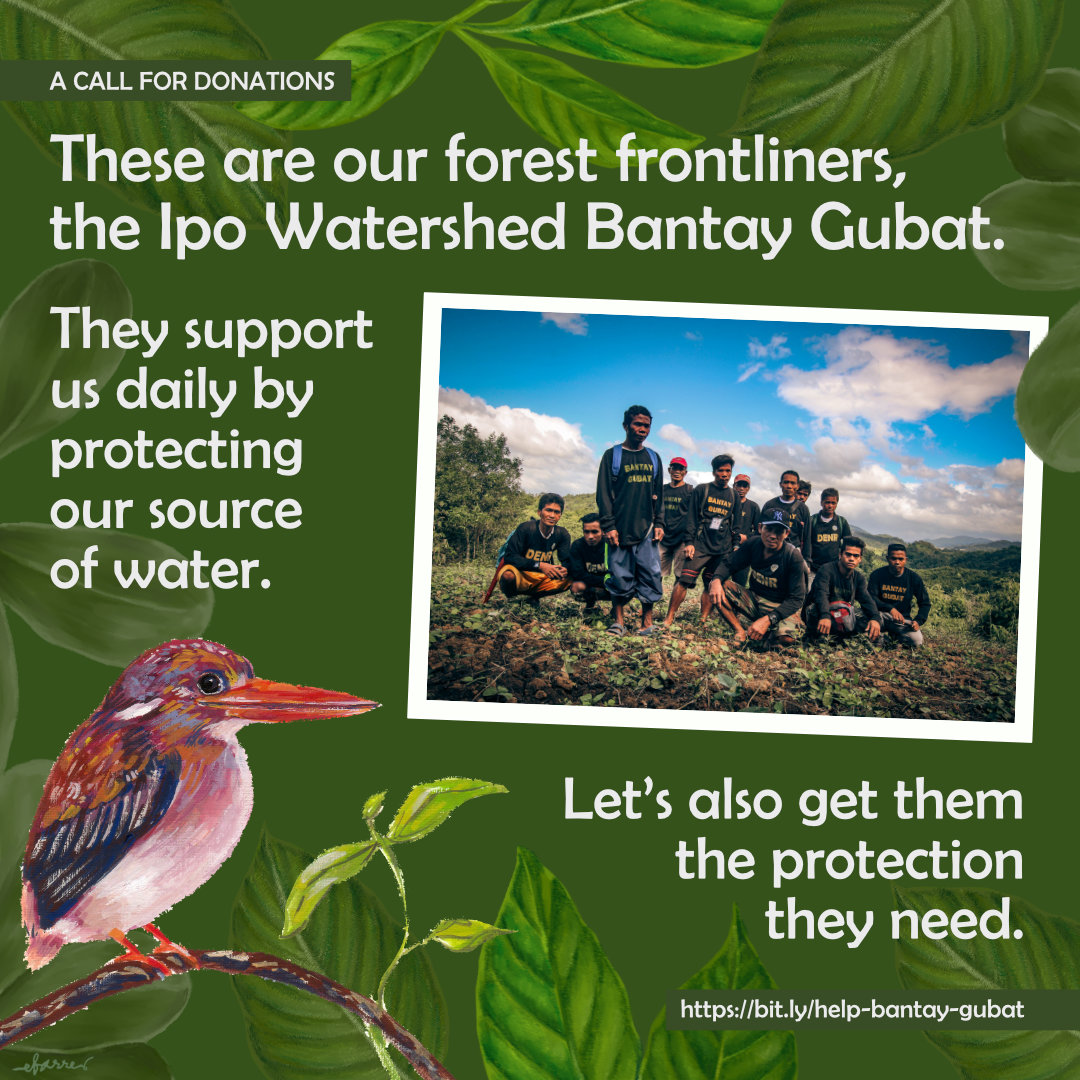
These rangers tirelessly patrol and monitor the Ipo watershed, a vital link in the Angat-Umiray-Ipo watersheds system that supplies about 96% of our water needs in Metro Manila, and they are in dire need of our support.
Bantay Gubat are not only responsible for protecting the watershed, they also help in forest and biodiversity conservation as they go about their rounds, checking for invasive species and signs of illegal activity. However, they can’t do this efficiently when they are lacking in equipment, and this is where we can help.
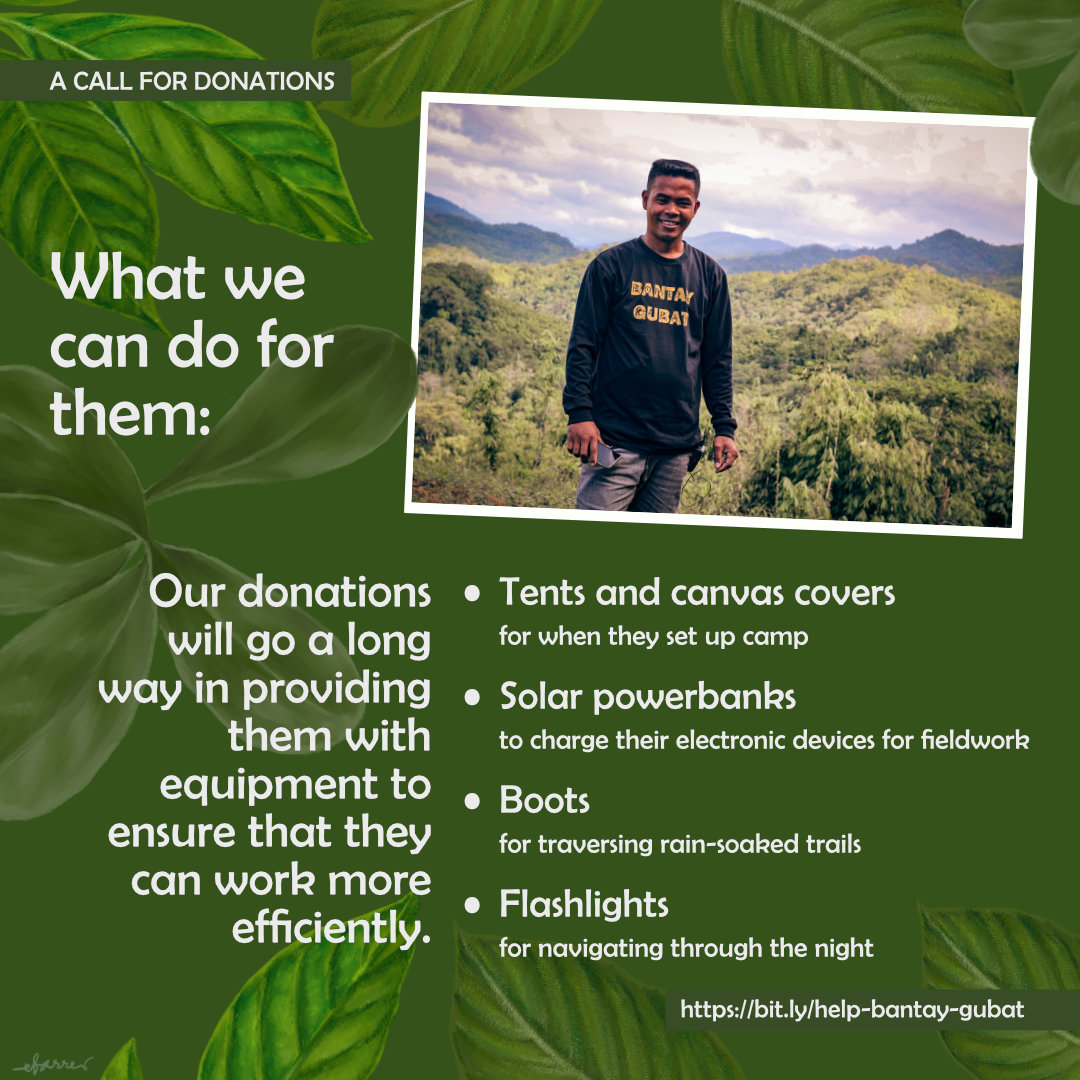
Please go to https://bit.ly/help-bantay-gubat . With the click of a button, you can donate any amount you can to help our forest rangers in securing our water supply, and in conserving our forest resources.
P.s. I have gifts for you ~

As a humble token of appreciation, I prepared exclusive desktop and mobile wallpapers featuring Philippine endemic forest birds for you kind-hearted nature nurturers! Just leave a comment below or send me a note if you’ve donated and I will send you the link to the high-res files. 🙂
by Cynthia B. Arre | Apr 5, 2020 | Advocacies, Downloadables
How are you holding up during this challenging period? Very grateful to the people holding the fort – our frontliners who are bravely risking their lives in service of the community and our country. Also trying to do my part – however small – by donating whenever and whatever I can, practicing physical distancing, and doing my best to stay healthy for the sake of my loved ones.
Last week, I posted my postcard that says “Kapit lang” (“Hang in there”) on Instagram and Facebook and received feedback that it could make a nice desktop wallpaper too — so here they are. They come in three sizes – one for desktop, one for mobile, and an eCard sized one for sending to friends and loved ones. 🙂

Download links:
Kapit Lang desktop wallpaper (2880 x 1800)
Kapit Lang mobile wallpaper (750 x 1334)
Kapit Lang eCard (700 x 438)
I also made another one that asks, “Kaya pa?” (loosely translated, “Can you still handle it?”) and it comes in all sizes too.
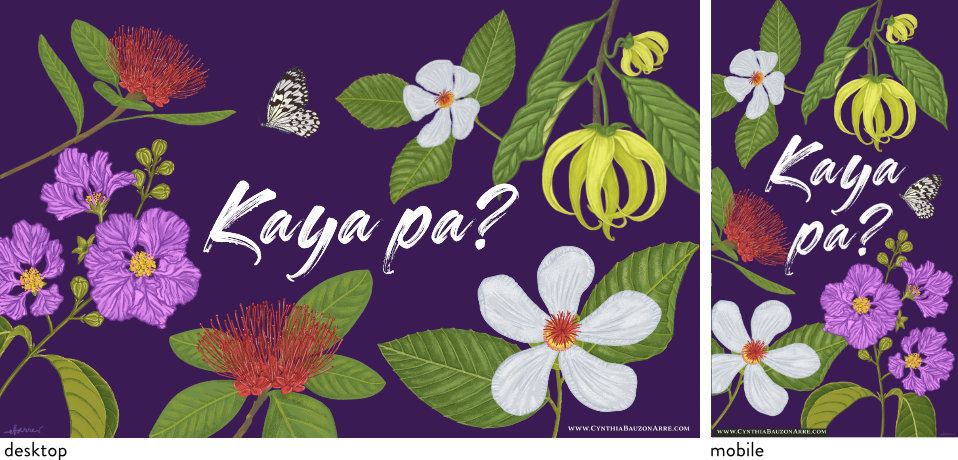
Download links:
Kaya pa? desktop wallpaper (2880 x 1800)
Kaya pa? mobile wallpaper (750 x 1334)
Kaya pa? eCard (700 x 438)
If you think these could cheer up someone you know especially at this time of uncertainty, please feel free to share these with them too. 🙂
Both designs feature flowers of Philippine native trees and plants. Can you name any or all of them?
If you want to receive a message when I have new freebies (downloadables, printables), you can leave a comment below, and don’t forget to tick the box. I promise not to use your address for anything else except for announcing when there’s something new. 🙂
by Cynthia B. Arre | Apr 26, 2019 | Advocacies
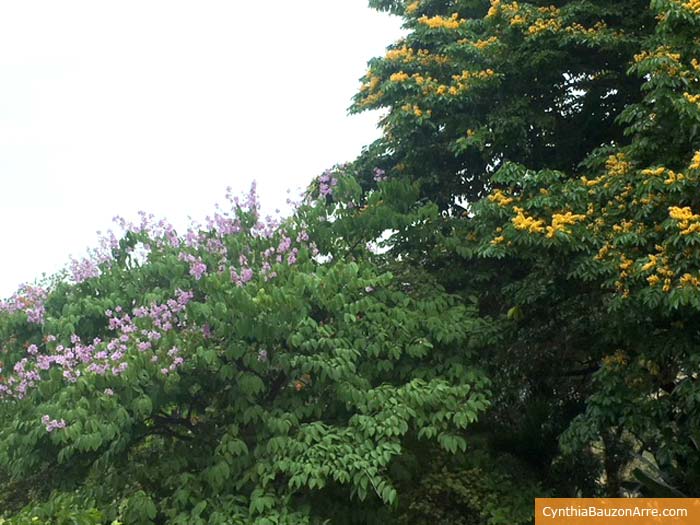
Banaba (Lagerstroemia Speciosa) and Narra (Pterocarpus Indicus), photographed at the UP Bahay ng Alumni in Diliman QC
Like many Filipinos I’ve marvelled at the beauty of the Sakura in Japan, but it’s the centuries-old traditions of “hanami” (flower-viewing) and especially “momijigari” (autumn leaves hunting) that struck a chord. The fact that people are willing to travel great distances and camp out for hours to catch the trees change color was astounding to me. I can’t help but wish that we had that same kind of enthusiatic appreciation for what we have, our own native trees. I wish we had more local parks lined with rows upon rows Narra, Molave, and Banaba trees, all lush with their respective yellow-orange, light blue, and lavender flowers. Wouldn’t that be amazing? The photo above which I took in UP Diliman last week is proof that native trees are around, but they are among exotic and invasive species like Mahogany, Flame tree, Acacia etc. which are in fact more well-known — I personally didn’t know they were introduced species until I started getting interested obssessed with native flora a couple of years ago.
It’s about time we learned more about our native trees which are not only beautiful but also vital to the protection of our forests as well as the conservation of our biodiversity. Alarmingly, a lot of our indigenous wildlife are now critically endangered because of habitat loss due to diminishing forest cover.
In an effort to raise concern, I chose to showcase the beauty of our native flowers and birds in some of my stationery. Also last year, in a serendipitous case of passion points aligning, I had an opportunity to work with a purpose-driven team of forestry specialists from Forest Foundation Philippines to come up with materials and awareness activities. Because of its important message, I’d like to share the introduction printed in the Philippine Forest Blooms Planner, one of the products born out of the collaboration.
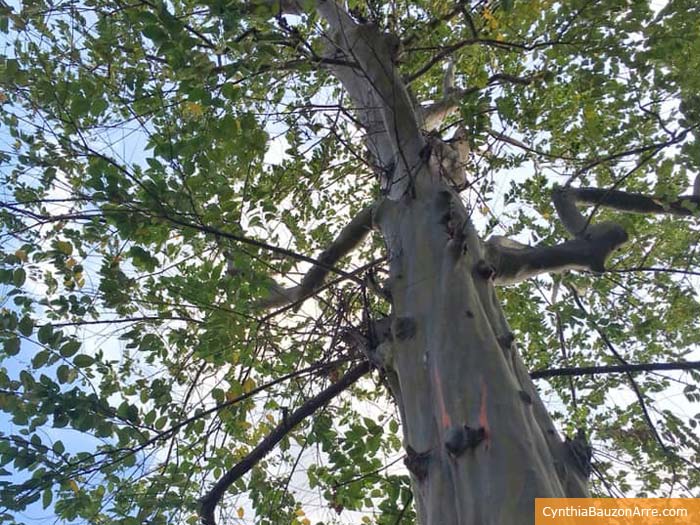
Bagras (Eucalyptus Deglupta), photographed in Ateneo during @TheAteneoWild Project’s Nature Walk
Forests give us life. Not only do they give us essential products, like food, water, wood, medicine and other materials, but forests also provide critical ecosystem services, like air purification, water in catchment areas and soil conservation, among others. In addition, for indigenous peoples, forests serve as a foundation of their culture. Without forests, we clearly won’t survive.
In the last decades, however, there has been a steady decline in the Philippine forests. From the original 27 million hectares of forest cover, it has decreased to 7.2 million hectares (DENR FMB, 2011). Reforestation efforts have been undertaken to address this problem. However, because the country, at that time, prioritized reforestation for timber production, most reforestation efforts used foreign or introduced species.
This brings us the question: Why do we plant trees? If we merely want to plant trees “for greening” denuded areas, or to engage in sustainable tree farming, then, perhaps, tree growing using any tree species, including foreign or introduced ones, will suffice. However, if we want to plant trees to restore our forests and conserve local biodiversity, then we need to use native trees.
Do you sometimes wonder why, however tall or sturdy a tree may look like, it can get uprooted quite easily during a typhoon? This might be because the tree is an introduced species not adapted to our local climate. In contrast, native trees adapt better to our environment hence their resilience to extreme weather conditions. Native trees also conserve an area’s biodiversity by forming intricate networks with birds, insects and other species by providing them homes.
In the recent years, there has been growing support for “rainforestation.” It refers to reforestation efforts that promote the use of native tree species to conserve the biodiversity and ecological integrity of our forests.
Through the Philippine Forest Blooms planner and the #DrawNativeTreesPH challenge we launched in social media last September 2018, we hope to raise awareness on the importance of our native trees in conserving and protecting our forests, while also introducing a few of our own beautiful trees.
If you would like to help raise awareness about our native trees, please continue to draw them and share the artworks with your friends by using the hashtag above. You can also use #ForestBloomsPh when you spot native trees and do share them with us, @forestfoundationph and @arncyn.









Recent Comments